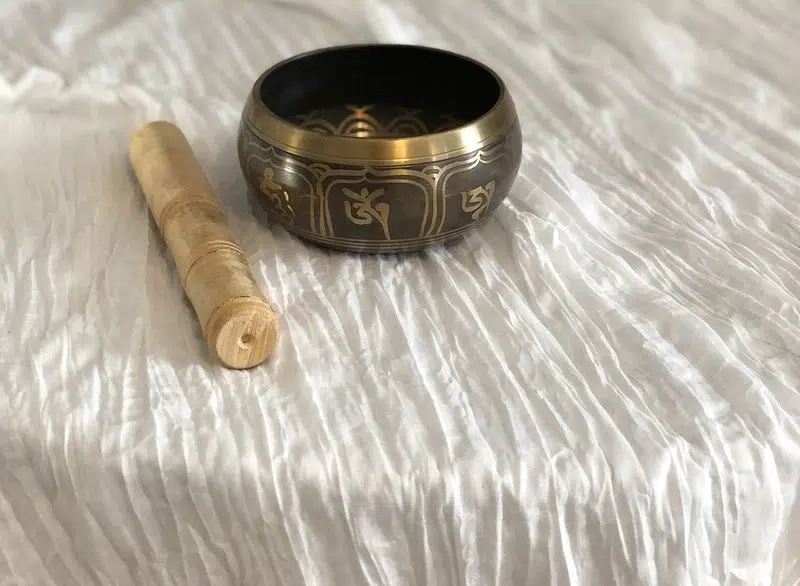Are you looking to enhance your meditation practice with a singing bowl? Understanding the direction (clockwise) in which you use your bowl can make a significant difference in the sound and vibration produced.
In this article, we will explore the techniques involved in using a singing bowl clockwise or anti-clockwise, and how it can bring balance and harmony to your practice.

Key Takeaways:
- Using a singing bowl in a clockwise or anti-clockwise direction impacts the sound and vibration produced.
- Techniques for both movements can enhance your meditation practice.
- Finding balance and harmony between the two directions can improve the restoring effects of the singing bowl.
Content
Understanding Singing Bowl Direction
When using a singing bowl, the direction in which you move the mallet around the rim can greatly impact the sound and vibration produced. There are two main directions to consider: clockwise and anti-clockwise.
When moving the mallet in a clockwise direction, it creates a sense of energy and warmth. This direction is associated with the sun and is known to balance the left side of the brain, which is responsible for logic and reasoning.
Clockwise movements are also said to stimulate the body’s sympathetic nervous system, which can help with digestion and increase energy.
On the other hand, moving the mallet in an anti-clockwise direction creates a sense of calmness and relaxation.
This direction is associated with the moon and is known to balance the right side of the brain, which is responsible for creativity and intuition.
Anti-clockwise movements are also said to stimulate the body’s parasympathetic nervous system, which can help with rest and relaxation.
It is important to keep in mind that the direction in which you move the mallet can also affect the specific sounds and vibrations produced by the bowl.
Clockwise movements tend to create higher-pitched sounds, while anti-clockwise movements produce lower-pitched sounds.
To fully experience the benefits of a singing bowl, it is recommended to explore both movements.
This can create a sense of balance and harmony within the body and mind, leading to a more fulfilling meditation practice.
Techniques for Clockwise Singing Bowl Practice:
Using a singing bowl in a clockwise direction can enhance your meditation practice. Here are a few techniques to get you started:
| Technique | Description |
|---|---|
| Striking the Bowl | Hold the bowl in your non-dominant hand and the mallet in your dominant hand. Gently strike the bowl near the rim with the mallet. Allow the sound and vibration to fill the space around you. Repeat as desired. |
| Circular Motion | Place the mallet on the rim of the bowl and begin to move it in a clockwise direction. Keep your hand steady and maintain a consistent speed. Listen as the sound and vibration change with each rotation. |
| Combining Techniques | Experiment with combining striking and circular motions to create different sounds and vibrations. Try different speeds and pressures to find the technique that resonates with you the most. |
Incorporating these techniques into your daily meditation practice can help you find balance and harmony within yourself.
Remember to approach your practice with an open mind and heart, and let the singing bowl guide you on your journey toward inner peace.
Exploring Anti-Clockwise Singing Bowl Methods

If you’re looking to expand your singing bowl practice, exploring anti-clockwise techniques may be the perfect way to do so.
This movement can create a unique sound and vibration that can be just as beneficial as clockwise techniques.
To use an anti-clockwise singing bowl, start by holding the bowl in your non-dominant hand with your fingertips on the rim.
Use your dominant hand to strike the outer edge of the bowl with a mallet, moving the mallet counterclockwise around the bowl. As you strike the bowl, feel the vibration move through your body and focus on creating a clear and resonant sound.
Another technique involves moving the mallet around the edge of the bowl in an anti-clockwise direction while holding the bowl with both hands.
This can create a more subtle and calming sound, perfect for meditation and relaxation.
It’s important to remember that finding a balance between both techniques can greatly enhance your practice.
Consider alternating between the two directions to create a sense of equilibrium and to fully experience the therapeutic effects of the singing bowl.
Finding Balance and Harmony
Whether you prefer using a singing bowl clockwise or anti-clockwise, it’s important to find balance and harmony in your practice.
By using the singing bowl in a clockwise direction, you can stimulate the flow of energy and promote relaxation.
This technique is ideal for starting a meditation session, as it helps calm your mind and ground your energy.
Alternatively, using the singing bowl in an anti-clockwise direction can help release stagnant energy and clear negative blockages.
Experiment with incorporating both movements into your practice, paying attention to how each one feels and the impact it has on your mind and body.
Remember, the purpose of using a singing bowl is to achieve a sense of harmony and balance within yourself.
By finding the right balance between singing bowl techniques, you can improve the therapeutic effects and achieve a more profound level of ease and internal calmness.
Conclusion
Congratulations, you have learned about the importance of singing bowl direction in your meditation practice!
Whether you prefer singing bowl clockwise or anti-clockwise movements, it is crucial to find a balance between the two techniques.
By understanding the impact of each direction on the sound and vibration of the bowl, you can experiment with different techniques to enhance your experience.
Incorporating both movements can create a sense of equilibrium and harmony.
Remember to focus on finding balance and harmony in your practice. Experiment with different techniques to find what works best for you.
By utilizing singing bowl techniques in your meditation practice, you can achieve a deeper sense of relaxation and inner peace.
